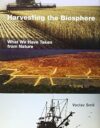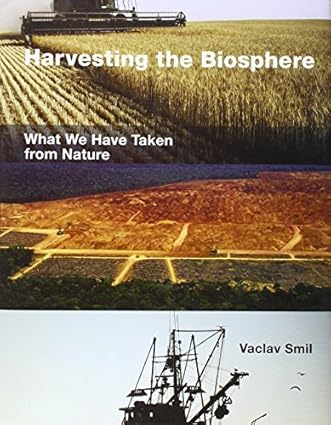
Original price was: €8.17.€4.39Current price is: €4.39.
Harvesting The Biosphere Price comparison
Harvesting The Biosphere Price History
Harvesting The Biosphere Description
Discover “Harvesting The Biosphere” Your Gateway to Sustainable Innovation
Are you looking for an insightful read on sustainability? Harvesting The Biosphere provides essential knowledge and transformative ideas for living in a balanced world. Its focus on the delicate interaction between humans and our environment sparks critical understanding and innovative approaches. If you search for Harvesting The Biosphere price or Harvesting The Biosphere review, you’ll find that this book has gained significant attention in eco-centric discussions.
Key Features of “Harvesting The Biosphere”
- Thorough Exploration of Sustainability: This book delves deep into ecological sustainability, providing actionable insights for individuals and communities.
- Intuitive Frameworks: Readers are equipped with frameworks that bridge scientific understanding and everyday application.
- Rich Illustrations: Beautiful visuals accompany detailed analysis, enhancing comprehension of complex ecological concepts.
- Interdisciplinary Approach: Combines perspectives from various fields, promoting a holistic understanding of global biospheric systems.
- Timely Discussions: The book touches on pressing contemporary issues surrounding climate change and resource management.
Benefits of Reading “Harvesting The Biosphere”
Engaging with this book empowers readers to:
- Enhance their understanding of ecological interconnections.
- Embrace sustainable practices that positively impact the environment.
- Foster community discussions around sustainability.
- Make informed decisions in their daily lives regarding resource use.
Price Comparisons Across Suppliers
When exploring the Harvesting The Biosphere price, you’ll find competitive pricing across multiple platforms. Currently, retailers like Amazon offer this compelling read at varying price points, making it accessible for everyone interested in sustainability. Regular promotions and discounts ensure you have options that fit your budget.
6-Month Price History Insights
The 6-month price history chart reveals interesting trends for this book. Prices have fluctuated slightly, with the average price reflecting increasing interest in sustainable living resources. This trend indicates a growing acknowledgment of ecological importance among readers, making now an excellent time to purchase.
What Customers Are Saying
Customer reviews highlight both the strengths and weaknesses of “Harvesting The Biosphere.” Here’s a summary of their insights:
- Positive Aspects: Many readers commend its easy-to-understand explanations and informative visuals. They appreciate the book’s ability to make complex ecological theories accessible.
- Constructive Critiques: Some reviews mention a desire for more localized examples, as the global perspective may feel distant to certain audiences.
Related Unboxing and Review Videos
If you’re curious about what to expect, you may find unboxing or review videos on platforms like YouTube particularly enlightening. These videos give visual representation and firsthand reviews of the book’s content and value, helping guide your purchasing decision.
Final Thoughts
“Harvesting The Biosphere” is an essential read for anyone passionate about sustainability and ecological innovation. It blends insightful content with practical applications, making it a valuable addition to your collection. With competitive pricing and a surge in popularity, there’s no better time to explore what this book has to offer.
Ready to make a difference in your understanding of ecology? Compare prices now!
Harvesting The Biosphere Specification
Specification: Harvesting The Biosphere
|
Harvesting The Biosphere Reviews (12)
12 reviews for Harvesting The Biosphere
Only logged in customers who have purchased this product may leave a review.












Max Kummerow –
Smil has written a number of books about human impact on the planet. This one is summed by by the calculation that about 99% of land vertebrate biomass on earth consists of humans and their domestic animals. The aim of the book is to examine how much of the earth’s biological productivity humans use. This suggests how much further human economies and food supplies can increase. The limits to growth are clearly in sight–in fact, we already use enough to seriously destabilize the very systems that support us. The science is pretty solid, which makes it a slog in places, but I like the fact that this book makes a serious attempt to get the science right by looking at these questions carefully.
C. Bensen –
I didn’t know this was going to be a textbook, but it is a comprehensive guide to calculating how much life we have on our earth, and how much we take it.
Great book for anyone seriously interested in the science behind our modern society.By serious I mean you’re a masters student or professor. This is NOT a bedtime read.
Amazon Customer –
An incredible interesting book
Adriano –
Autor une rigor academico a um texto agradável e fluido. Texto muito interessante para um tema atual e crítico (meio ambiente)
Pertti Ranta –
Amazing, filled with insigthfull information
William Carpenter –
Vaclav Smil’s Harvesting the Biosphere: What We Have Taken from Nature is not an easy book to read. It is full of statistics such as this excerpt: (… 15MJ/kg for grains and more than 16MJ/kg for fatty meat). Despite this, the book is fascinating!
Smil analyzes the mass of the biosphere, i.e. all of the Earth’s life including plants, animals, and other living matter. He calculates how much of this living matter there is and how much of that total is used by humans. He also, incidentally, imparts really interesting tidbits about the extinction of mammoths and other megafauna, the importance of forests, the impacts of whaling, and lots of other interesting topics. It seems that we still haven’t learned how to handle fire – one of the largest human impacts on the world historically has been the burning of forests – much of which was and is accidental.
In this period of uncontrolled global warming, one might expect the author’s conclusions to be uniformly pessimistic. Smil surprises with a somewhat optimistic final chapter on long-term trends. He ends with a set of recommendations, well supported by the evidence in this book, that we need to stabilize our global population, eat less meet, waste less food, share the world’s resources more equitably, and manage the demand for wood. I hope we listen to him!
Russell –
a very scientific read, recommended for high level readers, yet still important.
Chad M –
This book is laden with facts and milestones about the biosphere. Here are some of the highlights of Prof. Smil’s book:
a. about 40% of all of terrestrial phytomass – trees, brush, grass – has been removed. To me, this paints of picture of a world heading toward unprecedented desertification. Even at this figure, the world is rapidly clearing and burning the tropical rainforests;
b. the ocean’s zoomass or animal matter is perhaps that most vulnerable area in next few decades, according to the author. This is well described in the final chapter;
c. biomass harvests for biofuel, using so-called crop waste, imperils the health and water-absorbing capability of soils. Biomass fuel is not a good answer at large scales.
d. land and ocean mammals are at 10% of historic levels, for many species. More ocean and land disruptions will imperil the final 10% of remarkable fellow mammals.
Harvesting the biosphere, crowding out the diversity of life, and the road to global desertification. Can it be turned around? Prof. Smil offers impartial and practical advice in the last chapter. This book complements the author’s other excellent books. Hopefully the summary and concluding chapter of this book will be shared among many educated people in the world.
The Gates Foundation is listening to Prof. Smil. Also, Bill Gates is personally a fan of Smil’s books. How many other major foundations and think tanks are paying attention?
On a final note, this book makes it clear that human civilization’s strategy of natural resource exploitation combined with indefinite population growth is a culture that is thousands of years old and unfortunately one that is archaic, worn-out, and now obsolete. Periodic surges and collapses of society’s have occurred, and now Jared Diamond observes that a near global collapse may be a few decades away. The world needs a new vision of humanity living in symbiosis with the natural world, improving some areas and utilizing specific designated areas, instead of the other way around where protected areas are the exception rather than the rule. Understanding the need for a civilization-biosphere symbiosis is just the beginning of an effort by scientists to formulate and promote such a new civilizational strategy.
M Burkhart –
Good book, thought provoking, I have not yet finished it, but like it very much, and will definitely re read
emil gigov –
I enjoyed one of his previous books (on the Oil industry) but this one is really dry with little commentary and too many stats from obscure studies
Stephen C. Baer –
If you are interested in who we are and what we have been doing for millennia, read this book. The subtitle, “what we have taken from nature” sets a tone of these remarkable 300 pages. Smil has his doubts about us. Who wouldn’t?
In some pages I find the tone of Scientism, the substitution of scientific jargons for what could be said more simply. Why be restricted to his prefixes when quantities could be spelled out even stated several ways for instance T remains mysterious to me until I look up that it stands for 1012, a million million or terra. Has Smil done this on purpose to jar us into a fresh look? Like a hard hat on a construction site is his language stilted for good reason?
What keeps me reading Smil after finishing most of his 30 books is the freshness of his observations, how surprising he is. An author with an identifiable agenda becomes tiresome, not Smil. Every topic, as “did early man kill off big game”, draws an original stream of references, quantities and questions. How can he refer to so many books and journals without ever seeming bookish? Facts and statistics reported by this omniscient guide blend into an unfinished song or poem not a library shelf.
The wonder is in Smil’s original look at things. Can’t he ever learn “to play ball” he must infuriate colleagues. Imagine him comparing how the satellites see his home town, Winnipeg to what he knows better. And can he really suggest that now and then man gives to Nature? Wasn’t his theme just the opposite?
This extensive study of man becoming the dominate, horrifying force throughout the planet, plowing up North America, Brazil, China and everywhere else, straining the vast oceans through our fishing nets, is alarming. We can stop and consider, before we sink into despair, that along with many degradations we have also produced a Smil.
Steve Baer
Thales –
The book has not met my expectations. I was looking for an easy explanation of what we take from the earth and what we should do to insure our food for the future with the coming growth of population. Some of this information was available but in a really academic way.